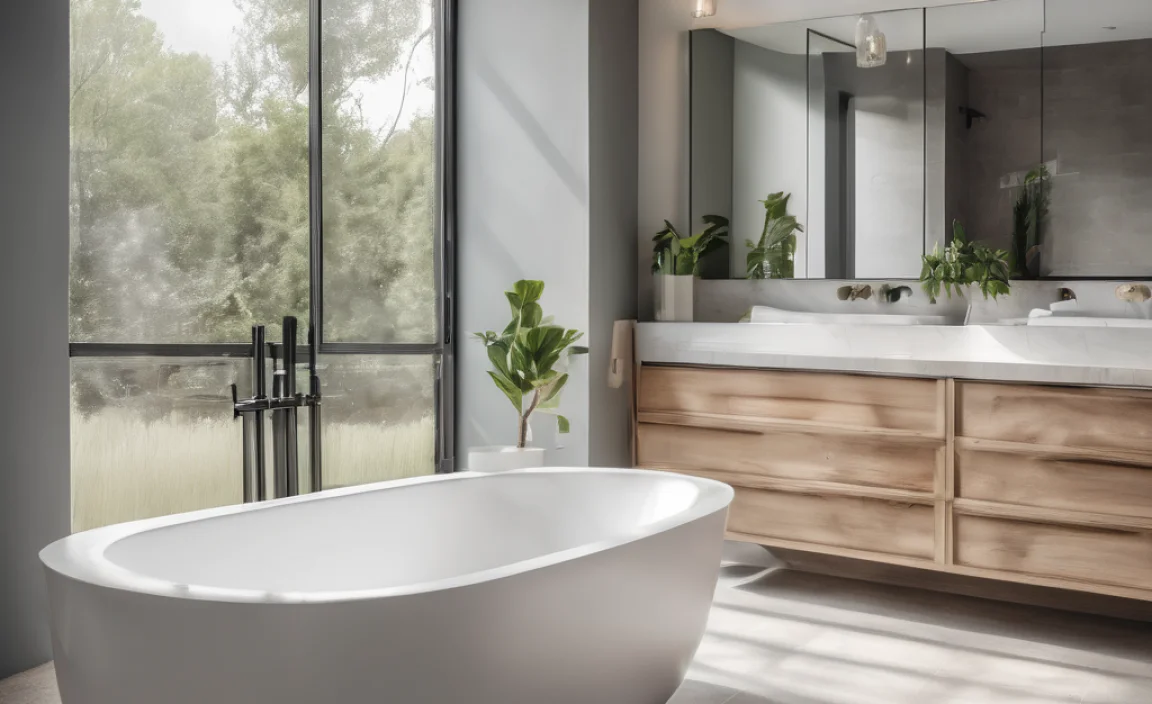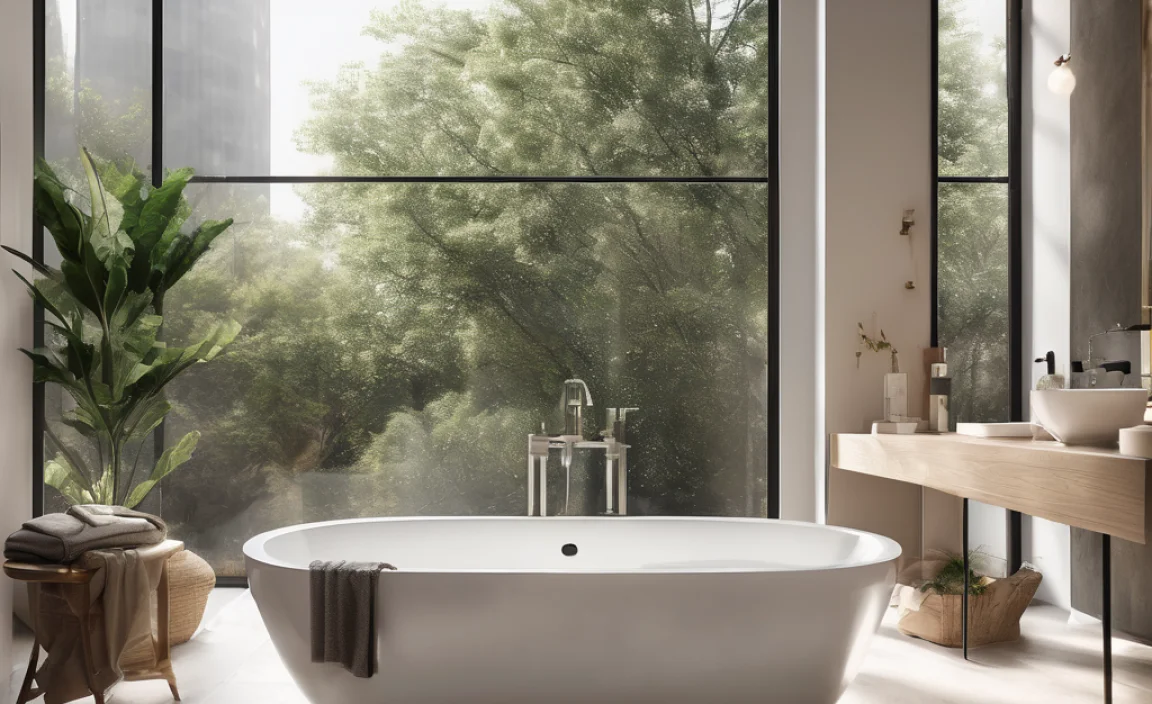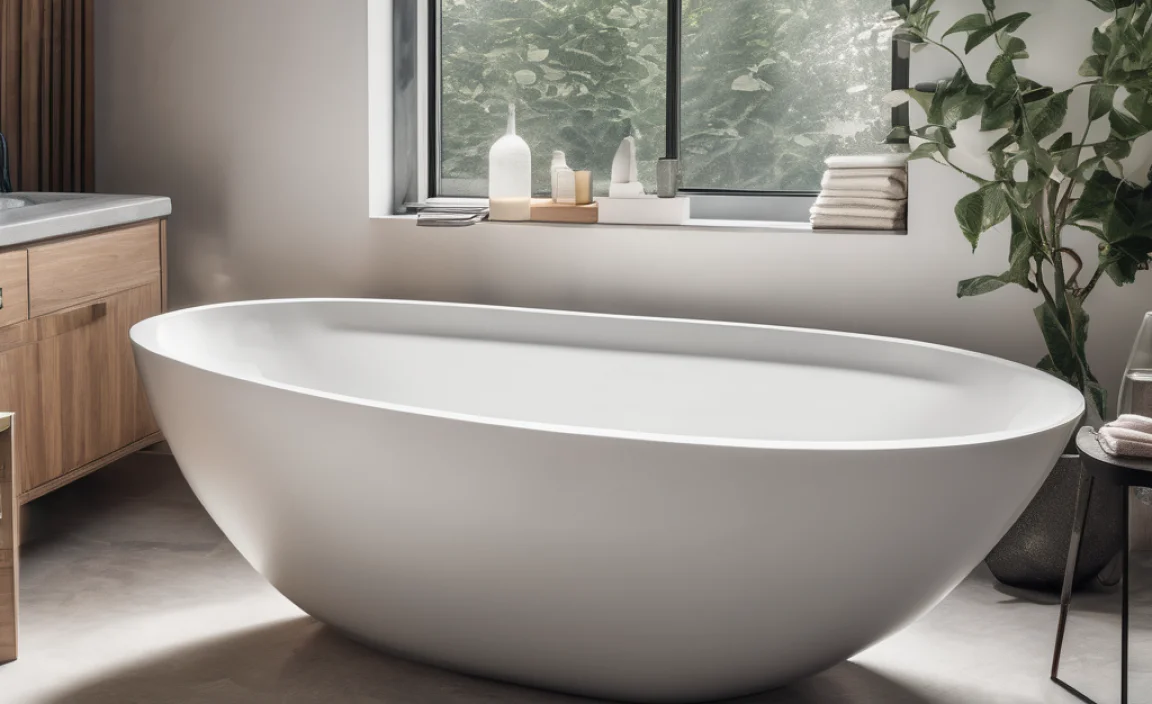How Much Are New Bathtubs?
On average, a new bathtub costs between $300 and $8,000, including installation. The price varies widely based on the material, size, type (alcove, freestanding, corner), and any special features like jets or built-in heaters. DIY installation can save money, but professional installation ensures proper plumbing and a watertight seal.
Thinking about replacing that old, stained tub? Or maybe you’re designing a new bathroom and dreaming of a luxurious soak? Figuring out the cost of a new bathtub can feel overwhelming. There are so many choices, from basic models to fancy whirlpool tubs. Don’t worry! This guide breaks down the costs involved, step-by-step. We’ll cover everything from the tub itself to installation fees, so you can plan your bathroom upgrade with confidence. Let’s dive in and get you soaking in style!
Breaking Down the Cost of a New Bathtub

Several factors influence the final price of your new bathtub. Understanding these elements will help you make informed decisions and stick to your budget.
- Type of Bathtub: Different styles have different price points.
- Material: Acrylic, cast iron, and steel all have varying costs.
- Size and Dimensions: Larger tubs and unique shapes generally cost more.
- Features: Jets, heaters, and other extras add to the overall price.
- Installation: DIY vs. professional installation impacts the final cost.
Bathtub Types and Their Average Costs

The type of bathtub you choose significantly affects the price. Here’s a rundown of common types and their typical cost ranges:
Alcove Bathtubs
Alcove tubs are the most common and budget-friendly option. They are designed to fit into a three-walled enclosure, making them ideal for smaller bathrooms.
- Average Cost: $200 – $800 (tub only)
- Pros: Affordable, space-saving, easy to install.
- Cons: Basic design, limited features.
Drop-In Bathtubs
Drop-in tubs are installed into a framed enclosure, allowing for more design flexibility. You can customize the surrounding deck and add decorative elements.
- Average Cost: $300 – $1,500 (tub only)
- Pros: Customizable, versatile design options.
- Cons: Requires a custom frame, higher installation costs.
Freestanding Bathtubs
Freestanding tubs are a luxurious and stylish option, standing alone without any surrounding enclosure. They make a statement and can be placed almost anywhere in the bathroom.
- Average Cost: $500 – $8,000+ (tub only)
- Pros: Elegant design, focal point of the bathroom.
- Cons: Expensive, requires more space, complex plumbing.
Corner Bathtubs
Corner tubs are designed to fit into a corner of the bathroom, maximizing space and adding a unique design element.
- Average Cost: $400 – $2,000 (tub only)
- Pros: Space-saving, unique design.
- Cons: Can be awkward to clean, limited styles.
Walk-In Bathtubs
Walk-in tubs are designed for accessibility, featuring a door that allows you to enter the tub without stepping over a high threshold. They are ideal for seniors or individuals with mobility issues.
- Average Cost: $2,000 – $10,000+ (tub only)
- Pros: Safe and accessible, therapeutic benefits.
- Cons: Very expensive, slow draining, requires specific plumbing.
Bathtub Materials and Their Impact on Price

The material of your bathtub affects its durability, heat retention, and, of course, its price. Here’s a breakdown of common materials:
Acrylic
Acrylic tubs are lightweight, durable, and relatively inexpensive. They are made from a sheet of acrylic that is vacuum-formed and reinforced with fiberglass.
- Average Cost: $200 – $1,000
- Pros: Lightweight, easy to install, good heat retention, scratch-resistant.
- Cons: Can feel less sturdy than other materials, may flex under weight.
Cast Iron
Cast iron tubs are known for their durability and excellent heat retention. They are made by pouring molten iron into a mold and then coating it with enamel.
- Average Cost: $400 – $2,500
- Pros: Excellent heat retention, very durable, classic look.
- Cons: Very heavy, difficult to install, prone to chipping if not properly cared for.
Steel
Steel tubs are similar to cast iron but lighter and less expensive. They are made from a steel sheet coated with enamel.
- Average Cost: $150 – $800
- Pros: Lightweight, less expensive than cast iron.
- Cons: Poor heat retention, prone to chipping, can be noisy.
Copper
Copper tubs are a luxurious and expensive option, known for their unique look and excellent heat retention. They are made from pure copper or a copper alloy.
- Average Cost: $2,000 – $8,000+
- Pros: Excellent heat retention, antimicrobial properties, unique appearance.
- Cons: Very expensive, requires special cleaning and maintenance.
Cultured Marble
Cultured marble tubs are made from a mixture of crushed marble and resins, creating a durable and attractive surface.
- Average Cost: $300 – $1,500
- Pros: Durable, attractive, easy to clean.
- Cons: Can be expensive, prone to staining if not sealed properly.
Here’s a table summarizing the average costs for different bathtub materials:
| Material | Average Cost | Pros | Cons |
|---|---|---|---|
| Acrylic | $200 – $1,000 | Lightweight, easy to install, good heat retention | Can feel less sturdy |
| Cast Iron | $400 – $2,500 | Excellent heat retention, very durable | Very heavy, difficult to install |
| Steel | $150 – $800 | Lightweight, less expensive than cast iron | Poor heat retention, prone to chipping |
| Copper | $2,000 – $8,000+ | Excellent heat retention, antimicrobial | Very expensive, requires special cleaning |
| Cultured Marble | $300 – $1,500 | Durable, attractive, easy to clean | Can be expensive, prone to staining |
Additional Features and Their Costs

Adding extra features to your bathtub can enhance your bathing experience, but they also add to the overall cost.
Jets and Whirlpool Systems
Whirlpool tubs feature jets that massage and relax your muscles. These can significantly increase the price.
- Average Cost: $300 – $2,000+ (in addition to the base tub cost)
- Considerations: Requires electrical connection, more maintenance.
Heated Backrests
Heated backrests provide added comfort and relaxation during your bath.
- Average Cost: $100 – $500+ (in addition to the base tub cost)
- Considerations: Requires electrical connection.
Chromatherapy Lighting
Chromatherapy lighting uses colored lights to create a relaxing and therapeutic atmosphere.
- Average Cost: $50 – $300+ (in addition to the base tub cost)
- Considerations: Requires electrical connection.
Overflow Drains
Overflow drains prevent water from overflowing, offering peace of mind and safety.
- Average Cost: $20 – $100 (in addition to the base tub cost)
- Considerations: Essential for deep soaking tubs.
Installation Costs: DIY vs. Professional

Installation costs can vary widely depending on whether you choose to DIY or hire a professional. Here’s a breakdown:
DIY Installation
If you’re comfortable with plumbing and have some experience, you can save money by installing the bathtub yourself. However, be aware of the risks involved. Improper installation can lead to leaks and water damage.
- Average Cost: $100 – $500 (for materials like plumbing fittings, sealant, and tools)
- Pros: Saves money on labor costs.
- Cons: Requires plumbing knowledge, risk of improper installation, may void warranties.
Professional Installation
Hiring a professional plumber ensures that the bathtub is installed correctly and safely. They will handle all the plumbing connections and ensure a watertight seal.
- Average Cost: $500 – $2,000+ (depending on the complexity of the job)
- Pros: Ensures proper installation, reduces risk of leaks, provides peace of mind, may be required for warranty coverage.
- Cons: Higher upfront cost.
Here’s a table summarizing the cost considerations for DIY vs. Professional Installation:
| Installation Type | Average Cost | Pros | Cons |
|---|---|---|---|
| DIY | $100 – $500 (Materials) | Saves on labor costs | Requires plumbing knowledge, risk of improper install |
| Professional | $500 – $2,000+ | Ensures proper install, reduces risk of leaks | Higher upfront cost |
Step-by-Step Guide to Estimating Your Bathtub Replacement Costs
Follow these steps to get a clear estimate of how much your new bathtub will cost:
- Determine the Type of Bathtub: Decide which type of bathtub fits your needs and bathroom layout (alcove, drop-in, freestanding, etc.).
- Choose the Material: Select the material that matches your budget and desired features (acrylic, cast iron, steel, etc.).
- Measure Your Space: Measure the available space in your bathroom to ensure the new bathtub will fit.
- Consider Additional Features: Decide if you want any extra features like jets, heaters, or lighting.
- Get Quotes: Get quotes from multiple suppliers and contractors to compare prices.
- Factor in Installation Costs: Determine whether you will DIY or hire a professional and factor in the associated costs.
- Add a Buffer: Add a 10-15% buffer to your budget to account for unexpected expenses.
Tips for Saving Money on a New Bathtub
Here are some tips to help you save money on your bathtub replacement project:
- Shop Around: Compare prices from different suppliers and retailers.
- Consider a Refurbished Tub: Refurbished tubs can be a more affordable option.
- Look for Sales and Discounts: Keep an eye out for sales and discounts, especially during holidays.
- DIY Demolition: If you’re hiring a professional for installation, you can save money by removing the old bathtub yourself.
- Keep Plumbing in the Same Location: Moving plumbing can significantly increase installation costs.
- Choose a Standard Size: Standard-sized tubs are generally less expensive than custom sizes.
Finding Reputable Contractors
If you decide to hire a professional for installation, it’s essential to find a reputable contractor. Here’s how:
- Ask for Recommendations: Ask friends, family, and neighbors for recommendations.
- Check Online Reviews: Read online reviews on sites like Angie’s List, Better Business Bureau, and Yelp.
- Verify Licensing and Insurance: Ensure the contractor is licensed and insured. You can usually check this with your local building department.
- Get Multiple Quotes: Get quotes from at least three contractors to compare prices and services.
- Ask for References: Ask for references from previous clients and follow up with them.
- Review the Contract: Carefully review the contract before signing, paying attention to payment terms, scope of work, and warranty information.
Visit the Better Business Bureau website to check the contractor’s rating and any complaints filed against them.
Maintaining Your New Bathtub
Proper maintenance will keep your new bathtub looking its best and extend its lifespan. Here are some tips:
- Clean Regularly: Clean the bathtub after each use with a mild soap and water solution.
- Avoid Abrasive Cleaners: Avoid using abrasive cleaners, as they can scratch the surface.
- Use a Soft Cloth: Use a soft cloth or sponge to clean the bathtub.
- Repair Chips and Cracks: Repair any chips or cracks promptly to prevent further damage.
- Protect the Surface: Use a bathtub mat or non-slip coating to protect the surface from scratches and stains.
- Ventilate the Bathroom: Ensure proper ventilation in the bathroom to prevent mold and mildew growth.
FAQ: New Bathtubs
How much does it cost to remove an old bathtub?
Removing an old bathtub typically costs between $100 and $500, depending on the complexity of the removal and disposal fees. DIY removal can save money, but it’s physically demanding.
What is the best material for a bathtub?
The best material depends on your priorities. Acrylic is affordable and lightweight, cast iron offers excellent heat retention and durability, and steel is a budget-friendly option. Copper is luxurious but expensive.
How long does bathtub installation take?
Professional bathtub installation usually takes between one and three days, depending on the complexity of the job and any necessary plumbing modifications. DIY installation can take longer.
Do I need a permit to replace my bathtub?
In many areas, you’ll need a permit to replace a bathtub, especially if you’re altering the plumbing. Check with your local building department to ensure compliance.
Can I install a bathtub myself?
Yes, you can install a bathtub yourself if you have plumbing experience and the necessary tools. However, improper installation can lead to leaks and water damage, so consider hiring a professional if you’re unsure.
What are the standard bathtub sizes?
Standard bathtub sizes are typically 60 inches long, 30 inches wide, and 14 to 16 inches deep. However, sizes can vary depending on the type of bathtub.
How do I choose the right size bathtub?
Consider the available space in your bathroom, your personal preferences, and your budget. Measure the area carefully and choose a size that fits comfortably without overcrowding the room.
Conclusion
Replacing a bathtub can significantly enhance your bathroom’s look and functionality. Understanding the different types of bathtubs, materials, features, and installation options can help you make informed decisions and stick to your budget. Whether you choose a basic alcove tub or a luxurious freestanding model, careful planning and research will ensure a successful and satisfying bathroom upgrade. Don’t be afraid to shop around, get multiple quotes, and ask questions. With the right approach, you’ll be soaking in your new tub in no time!

